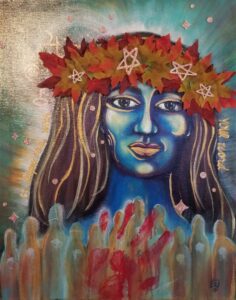
Guided Meditation to Connect with your Ancestors
I am pleased that you’ve joined me for

A chakra (“cha”-“kra,” pronounced with a strong “ch”) is a center of energy in the body that interacts with physiological and neurological systems within the human body. The word stems from Sanskrit, an ancient language originating in India, and means “wheel.” The wheel represents the motion made by the vortex of spinning energy that is each chakra in the body. The seven chakras are positioned throughout the body in line with the spine and regulate processes from organ function to the immune system and emotions.




Root Chakra: First chakra.Located at the base of the spine. Associated with the Earth element and the color red. The Sanskrit name for this chakra is “Muladhara,” meaning base, foundation, or root support. This chakra is associated with safety, survival, security, basic needs, physical identity, and grounding. Imbalance make the person feel as though they are constantly in “survival mode.”
Healing stones: red jasper, bloodstone, red carnelian, garnet, hematite, smokey quartz

Sacral Chakra: Second chakra.Located below the naval extending to the genital area. Associated with the element of water and the color orange. The Sanskrit name for this chakra is “Svadhisthana,” meaning “your own place.” This chakra is associated with sensuality, pleasure, and creativity. Because it’s element is water, it is characterized by flow and flexibility. Imbalance may result in codependency and the lack (or excess) of feelings and sexual desire. Healing stones: citrine, carnelian, moonstone, coral

Solar Plexus Chakra: Third chakra.Located above the naval near the diaphragm. Associated with the element of fire and the color yellow. The Sanskrit name for this chakra is “Manipura,” meaning “city of jewels.” This chakra is associated with intelligence and expression of will. Imbalance may result in the lack of direction, feelings of helplessness (underactive chakra), excessive control over others (overactive chakra). Healing stones: citrine, tiger’s eye, yellow tourmaline, topaz

Heart Chakra: Fourth chakra.Located in the center of the chest near the heart. Associated with the element of air and the color green. The Sanskrit name for this chakra is “Anahata,” meaning “unstruck”. This chakra is associated with compassion, love, and beauty. Imbalance may result in the inability to forgive, jealousy, or isolation. Healing stones: Jade; green calcite, tourmaline, or jasper; rose quartz

Throat Chakra: Fifth chakra.Located at the throat. Associated with the element of sound and the color light blue. The Sanskrit name for this chakra is “Vishudda,” meaning pure or purification. This chakra is associated with communication, expression, and creativity. Imbalance may result in insecurity and fear of speaking (underactive chakra); or lying and gossiping (overactive chakra). Healing stones: turquoise, aquamarine, lapis lazuli

Third-eye Chakra: Sixth chakra.Located between the eyebrows. Associated with light and the color dark blue, purple, or bluish purple. The most common Sanskrit name for the third eye chakra is “Ajna”, which means “command” and “perceiving”. This chakra is the center of intuition and foresight and it motivates thought, insight, and creativity. Imbalance may result in feeling stuck and a lack of vision (underactive chakra) or indulgence in fantasy and illusions (overactive chakra). Healing stones: amethyst, purple fluorite, black obsidian

Crown Chakra: Seventh chakra.Located at the top of the head. This chakra’s element is light and the color gold, white, or deep purple. The Sanskrit name “Sahasrara,” which can be translated as “Thousand petals”. It gives us access to the devine through higher states of consciousness as we open to what is beyond our personal preoccupations and visions. Imbalance may result in a lack of or excessive interest in spiritual beliefs and closed mindedness.
Healing stones: amethyst, clear quartz, diamond

I am pleased that you’ve joined me for

The throat chakra is the Fifth chakra. It

The third-eye chakra is the sixth chakra. It

The solar plexus chakra is the third chakra.
Lorem ipsum dolor sit amet, consectetur adipiscing elit. Ut elit tellus.